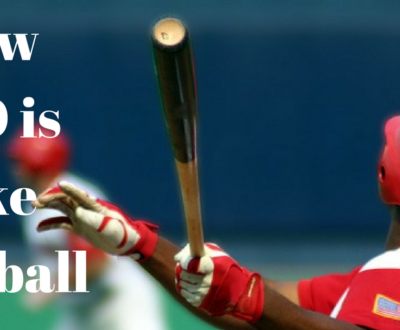OPTIMIZING FOR YOUTUBE’S ALGORITHM: IS IT THAT MUCH DIFFERENT FROM GOOGLE’S?
- August 17, 2022
- Blog, Social Media

Originally Shared BY ANDY ELIASON
Every so often, many popular YouTubers post a frustrated and angry video about how “YouTube is broken” again. It happens on a very nearly regular basis these days. People who rely on this platform for their livelihood are, understandably, upset when the platform that has worked a certain way for so long suddenly changed unknown elements for unknown reasons, and suddenly their usual numbers of views begin to go down a bit.
This latest wave really reminded me of how companies and SEOs have gone through the same thing over and over again. Though, it has to be said, in the search engine at large, we’ve at least come to expect the ongoing changes, even if we’re not exactly thrilled by them.

Still, it leads to a regular stream of articles and videos claiming that “SEO is dead” as loudly as those YouTubers claimed that YouTube is broken.
The real problem, we’ve noticed, is not the fact that people make these articles and videos. It’s that a lot of misconceptions can spread from them.
It’s easy to hear these claims of death or destruction and then project those claims on your own growing or declining views or visits. That’s all the evidence that they need to declare that something very bad is happening.
However, that may not really be the case.
But how can you know for sure?
YouTube is like a mini internet (your channel is your domain, your vids are your pages, etc.), and there are some things we can learn from it. So, today, I am going to look at a couple of videos and go over what they tell us about important behaviors on YouTube as well as the internet at large.
Now, this is a gaming YouTube channel – so be aware if that’s the kind of thing that really bothers you – but this particular video takes a break from being specifically about games and focuses on the current state of YouTube in an effort to explain the platform and the market to other YouTubers.
In the SEO world, YouTube isn’t usually about earning an income (though that would obviously be nice), but about supporting and promoting the business. That said, it is important to understand the platform you are using to promote your brand and develop your content strategy. So, there are some things worth learning from these videos.
This video starts with a YouTuber, h3h3Productions, expressing his frustration.
“I wish they would just explain what they’re doing. Just tell us what you want. What are you doing?”
Sound familiar?
If you’ve been in the SEO business for a while, it’s almost comforting to see these frustrations from another side of the online marketing spectrum.
Personally, I’ve been in this business in one form or another for a good decade or so. The cries for the terrible algorithm to just “tell us what it wants” is a familiar one.
[Related content: Should You Go In-house with Your Online Marketing or Outsource the Work?]
There’s a lot of shock and anger that people feel when all those things that once worked suddenly don’t. It’s upsetting to be on top of the heap for the longest time and then, suddenly, the things I was doing before (which were complete sufficient and above-board) are not enough.
Just think back to 2013 when Google took away most of our keyword data and replaced it with [not provided].
There was a lot of discontent shared on the internet that day, I can tell you.
And yet, we moved on. We get angry, but we’ve learned to expect the occasional drastic change.
The latest thing that seems to have angered up the YouTubers has something to do with the Trending tab, and whether or not the algorithm has changed what they promote through that part of YouTube. The fear is that these changes have directly impacted their views.
But my guess is that if you asked someone how often they used the Trending tab in YouTube, their response would be along the lines of: “the what tab?”
Nevertheless, there are quite a few videos that claim that this is obviously the source of their woes.
But, what does this video claim about that? What does his research show?
Well, first and foremost it shows that that YouTube is constantly changing. It hasn’t changed. It’s in a constant state of flux. Just like any other proper search engine.
That means it’s not about understanding what makes YouTube work. It’s about understanding what YouTube wants.
The same applies to Google. Even when they take away our keyword data, if you understand what it wants, you may understand why it’s doing it.
And then, you’ll be able to make more strategic decisions.
So, here’s what he learned from his research:
- Retention time is the basis of YouTube’s recommendations in searches.
- Watch Minutes are critical – and it has a direct impact on why seemingly low-quality and weird things seem to get promoted by the algorithm.
- This is also why so many of the videos that come up in the results are much longer than they once were.
YouTube is not about views anymore. It’s all about minutes. If you only watch 10 minutes of a weird, 20-minute video, that’s still more important to YouTube than watching the entire 3 minutes of a higher-quality video.
But it goes even further than that. YouTube doesn’t just want you to watch 10 minutes of a video, they want you to come back tomorrow and watch another 10 minutes. And then the day after that. And the day after that, too.
It’s this kind of consistent viewership that makes a channel seem more important to YouTube.
Sound familiar? That’s because it’s this kind of consistent readership that makes a website seem more important to Google. It’s a critical part of their judgmental algorithm. It may not have as big of an impact in Google as YouTube, but the search engine is definitely interested in how long people are staying on your site.
So, what does YouTube really want?
According to the theory in the video, they want you to be treated like a TV. They want you to turn it on naturally every day.
If you can work within that paradigm, chances are you’ll succeed on YouTube.
Trouble is, the people who are most likely to be able to deliver that kind of consistent content are the people who have already been doing so for years – the established television and production companies. This is why you’re probably seeing a lot more talk show and news show videos in your recommended list.
This is also why many small companies can feel like they’re at a disadvantage against established brands who have been securing their spot at the top of the SEO heap for years, and have the personnel necessary to produce a stream of consistently high quality content.
Your website does have some advantages over YouTube channels, though. Because YouTube is pushing the next, newest thing so hard, huge back catalogs of videos are not getting the views they once did.
On your website, however, you can create the kind of evergreen content that will still contribute to your site visitors for years to come.
This includes your video content. The above video is speaking to people who use YouTube to make a living. But if you focus on creating video content that is specifically tailored to support your customers or build your brand, there are a lot of evergreen uses for it, too.
Sounds pretty straight forward, right? So, let’s look at another video that gets a little deeper into internet user behavior.
As more YouTubers claimed that YouTube was broken, even more YouTubers started to believe it. Leading to a situation in which one of the most popular content creators claimed his was going to delete his channel after he reached 50 million subscribers. He seemed to feel it just wasn’t right that he had 50 million subscribers but was only averaging 2 to 3 million views on each video.
(Of course, he didn’t really delete his main channel, but he did delete a different one.)
One has to wonder if someone who expresses these kinds of frustrations isn’t quite understanding what YouTube wants. Even if he has some idea of how it works.
But then, as you watch the above video, you see that he may not understand the “how” all that much either. He’s apparently relying on the number of subscriptions and YouTube’s algorithms to send him more viewers.
But the thing is, YouTube’s algorithm doesn’t know what your video is about. It can’t judge the production values that went into it.
It’s only got your meta data – the title, description, and tags – to judge. And even if you have 50 million subscribers, it won’t know how to recommend your video to others if you simply have random, one-word titles.
In other words, people are getting mad because YouTube isn’t recommending them on the front page, but they have totally failed to give YouTube any hints about what they should be recommended for.
“I’m not going to let YouTube win!” Pewdiepie says in the video, which takes me back to another early SEO misconception. There was this notion that SEOs and search engines were inherently at odds. That it was somehow a battle, and that Google was doing things specifically to make things more difficult for any company that wanted to rank higher.
This, of course, is untrue. Success came when you worked with the search engines to provide what they wanted. (i.e. more content, better quality content, great user experience, etc.) The same will happen with these YouTube channels.
YouTube and Google simply have to keep changing to adapt, and we have to change along with them. Sometimes it’s easy to see why something changes. On YouTube, people were using misleading thumbnail images to get clicks. In the search engines, people used misleading descriptions and titles.
In both cases, the user would simply click away from the irrelevant or unwanted content.
And, in both cases, the algorithms changed to address the problem. As a direct result, time on side and Watch Minutes have become more important.
Things to Remember If YouTube is an Important Part of Your Content and Brand Strategies
So, we’ve seen how video optimization and regular search engine optimization face the same problems and have many of the same solutions. But let’s just take a closer look at some of the takeaways here:
- Make it clear what you want to be relevant for. Use the title, description, and tags to inform the algorithm what your video is about.
- Use key phrases that aren’t just about your keywords, but that YouTube can use to recommend your video to other similar searches.
- Create a constant flow of good content.
- Give them a reason to stay on the page or video.
- Find out what the algorithm wants, and work with it, not against it.
Optimizing for YouTube is a little different, of course, since it’s not just about reaching the first page. No video will be on the Recommended list forever. It’s about making yourself relevant enough to be included with other recommendations for as long as possible.
But, then again, maybe there’s something there that regular SEO can learn and adopt, too.
Want to see how a video content strategy fits into the rest of your online marketing efforts? Be sure to check out this free eBook:
Let us improve your online marketing results
We have increased traffic, leads, and sales for well-known companies—including Dell, Mrs. Fields Cookies, Hotels.com, and H&R Block.Plus for hundreds of local smaller companies like dentists, plumbers, dermatologists, etc.
About us and this blog
We are a full service agency that deliver compelling digital marketing solution. Our winning solutions and experience helps to deliver great results across several key areas.
Request a free quote
We offers professional SEO services that help websites increase organic search drastically and compete for 1st page rankings of highly competitive keywords.
Recent Posts
- HOW SEO IS LIKE BASEBALL September 10, 2022
- OPTIMIZING FOR YOUTUBE’S ALGORITHM: IS IT THAT MUCH DIFFERENT FROM GOOGLE’S? August 17, 2022
- 5 TOOLS AND TECHNIQUES TO HELP YOU IMPROVE YOUR BLOGGING TODAY July 19, 2022







